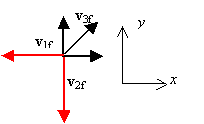Jx = 1/2(1000 N)((30 s) = 1.5 x 104 NĚs
b. At t = 30 s the rocket reaches its maximum speed.
Use impulse-momentum theorem
Dp = mvmax,x - mvix = Jx;
(425 kg)[vmax,x - (75 m/s) = 1.5 x 104 NĚs, vmax,x = 111.3 m./s
3mv3i + mv1i = 4mv4i;
3(2.0 m/s) + (4.0 m/s) = 4v4i, v4i = 2.5 m/s
Again from conservation of momentum
4mv4i + mv1i = 5mv5i;
4(2.5 m/s) + 0 = 5v5i, v5i = 2.0 m/s.
From conservation of momentum
x-direction: Mvix = m1v1fx + m2v1fx + m3v3fx; 0 = m(-20 m/s) + m(0) + 2mv3fx, v3fx = +10 m/s.
y-direction: Mviy = m1v1fy + m2v1fy + m3v3fy; 0 = m(0) + m(-20 m/s) + 2mv3fy, v3fy = +10 m/s
v3f = (v3fx2 + v3fx2)1/2 = [(-10 m/s )2+(-10 m/s)2]1/2 = 14.14 m/s.
θ = tan-1(v3fy/(v3fx) = tan-1[(-10 m/s)/(-10m/s)] = 45░.
The speed of the third piece is 14.14 m/s north of east.

mbulletvbullet,i + mblock1vblock1,i = mbulletvbullet,f + mblock1vblock1,f;
(0.01 kg)(400 m/s) + 0 = (0.01 kg)vbullet,f + (0.5 kg)(6.0 m/s), vbullet,f = 100 m/s.
Find the speed of the bullet when it stops.
mbulletvbullet,i + mblock1vblock2,i = mblock2+bulletvblock2,f,
(0.01 kg)(100 m/s) + 0 = (0.5 kg + 0.01 kg)vblock2,f, vblock2,f = 1.96 m/s.
vxi = v0cosθ0 = (125 m/s)cos 55░ = 72.7 m/s
As the explosion exerts horizontal force only, the initial speed of the heavier fragment is zero and the lighter fragment has horizontal component only after the explosion.
Find the speed of the lighter fragment immediately after the explosion.
Mvxi = m1v1xf+ m2v2xi
(75 kg)(72.7 m/s) = 1/5(75 kg)v1xf + 4/5(75 kg)(0),
v1xf = 358.5 m/s.
Find the height of the shell when it explodes.
vy2 = vy02 - 2gh,
0 = (125 m/s)sin55░]2 - (9.8 m/s2)h, h = 535 m.
Find the horizontal distance of the explosion point to the launch point.
x1 = 1/2R = 1/2v02sinθ0/g =1/2(125 m/s)2sin110░/(9.8 m/s2) = 749 m.
Find the time the lighter fragment in the air.
h = 1/2gt2;
(535 m) = 1/2((9.8 m/s2)t2, t = 10.4 s
Find the distance of the lighter fragment it lands from the explosion point.
x2 = v1xft = (358.5 m/s)(10.4 s) = 3.73 x 103 m
x = x1 + x2 = 749 m + 3.73 x 103 m = 4.5 x 103 m